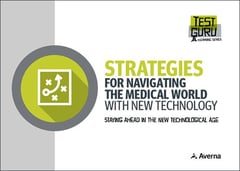 Imagine if you were in the doctor’s office having an important test done and all of a sudden the medical equipment the doctor is using starts malfunctioning. Not a good situation to be in!
Imagine if you were in the doctor’s office having an important test done and all of a sudden the medical equipment the doctor is using starts malfunctioning. Not a good situation to be in!
To put it bluntly, there’s no room for error when it comes to medical devices. Equipment that is dependable and accurate helps keep people healthy and alive. So when these products come to market, they are expected to work by the medical professionals who use them, and more importantly, by the patients who depend on them. This means that the highest calibre testing is necessary because any flaws not discovered and remedied before the product hits the market could mean the difference between life and death.
But how do OEMs deliver superior quality equipment in a rapid-fire, competitive market that keeps moving with or without you? Here are five tips that will help you maintain your edge:
1. Work with a company that excels at Design for Test (DFT) and Design for Manufacturing (DFM). The earlier you identify and eliminate product design flaws in the product lifecycle, the better. These processes help you save time and money while avoiding frustrations and setbacks.
2. Automate testing. Wherever possible, automate product validation and verification (V&V) routines. No matter how disciplined or professional your employees are, they’ll introduce variability and subjectivity into test procedures and results. Automated testing provides objectivity and repeatability, essential for proper decision-making, fast troubleshooting, and regulatory compliance.
3. Use industry-standard hardware and software. While proprietary systems may initially work for you, they don’t scale or replicate well and ultimately expose companies to risk associated with too much tacit knowledge combined with inflexible systems. A robust, industry-standard test environment is simpler to manage and update, and easier for a new hire to learn if a key team member leaves the company.
4. Capture and analyze up-to-date test data. The best way to identify and correct problems, simplify processes, and monitor progress is to access clean and consolidated data. It provides all stakeholders with an important, and common, frame of reference as well as shared analysis tools.
5. Focus on what you excel at and outsource everything else. In today’s fast-paced, high-tech world there are few things financially riskier than trying to develop a non-core capability from scratch. It’s much better to partner with a company that has crucial skills or products in areas where you’re not as strong.
In a hectic and competitive medical device market OEMs are expected to deliver equipment that is dependable when it really counts. And accurate, efficient testing plays a crucial role in this delivery. Using these tips will help avoid financial loss, reputational damage, and possibly loss of life. Think about that next time you’re in the doctor’s office.
Want to learn more about the medical industry?
Get in touch with our experts or navigate through our resource center.
Download this eBook to find out what changes the medical industry is facing and the best ways to stay ahead in this new technological age.
